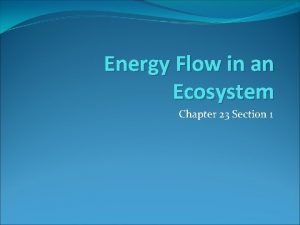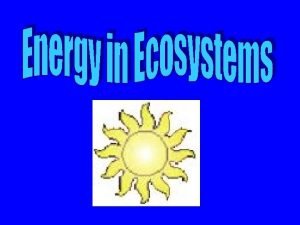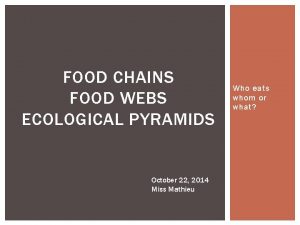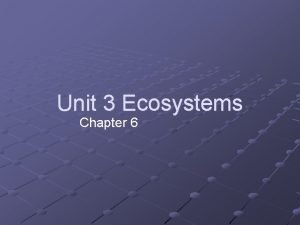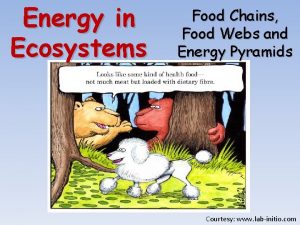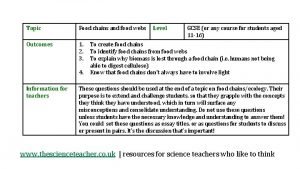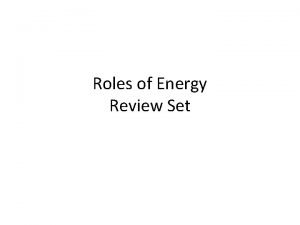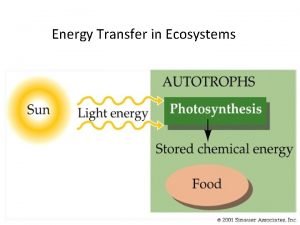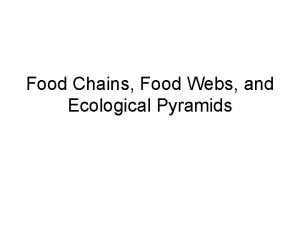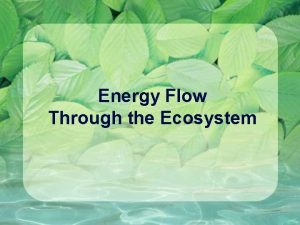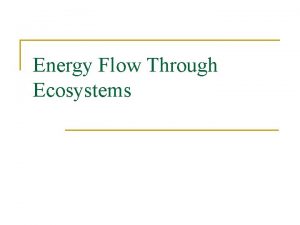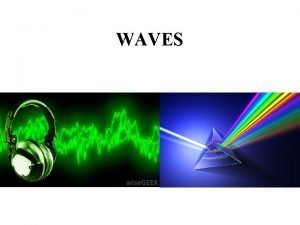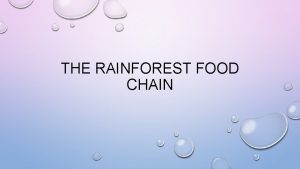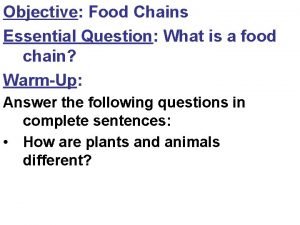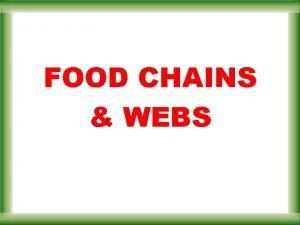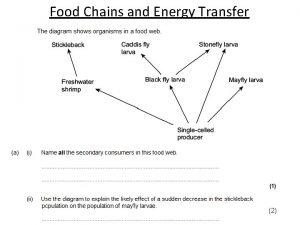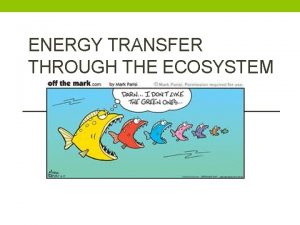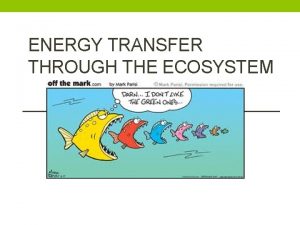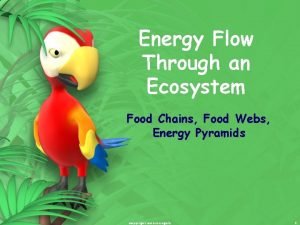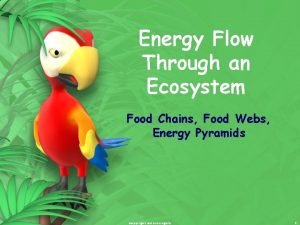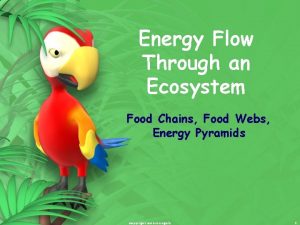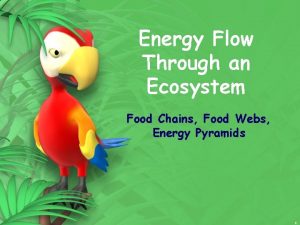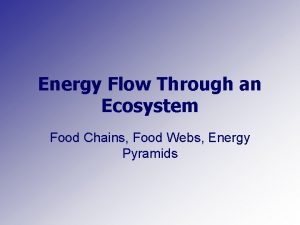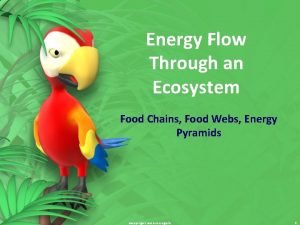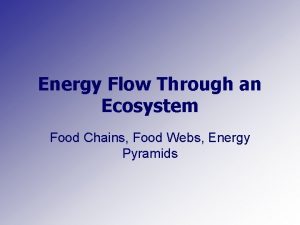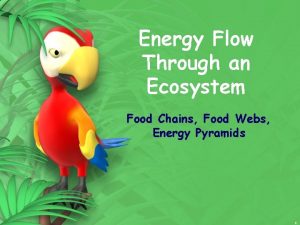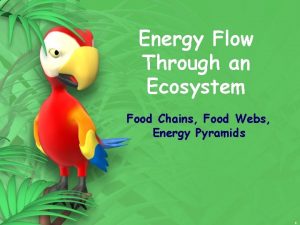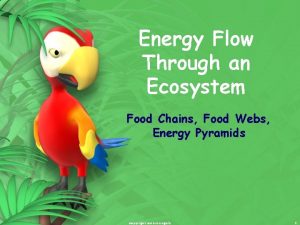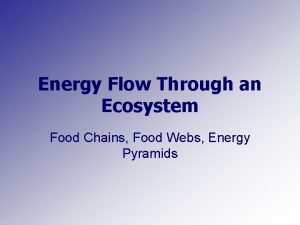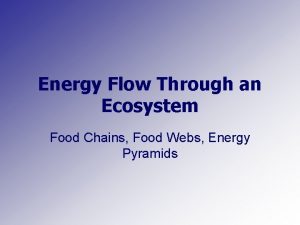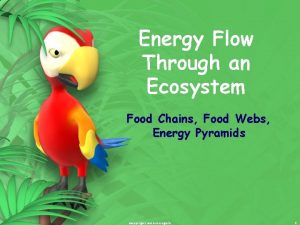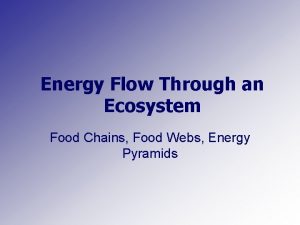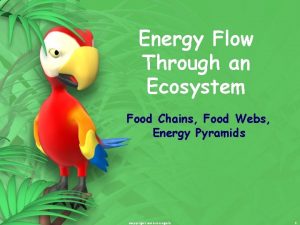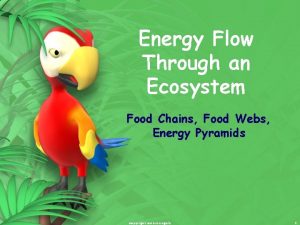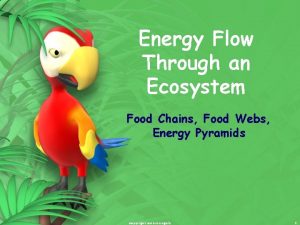ENERGY TRANSFER THROUGH THE ECOSYSTEM Food Chains and




























- Slides: 28

ENERGY TRANSFER THROUGH THE ECOSYSTEM

Food Chains and Webs We prefer food webs as it shows all the food chains in a particular ecosystem and how they interact.

Using this food web Identify a: Producer Primary Consumer An organism that occupies more than 1 trophic level Which group of organisms are missing from this food web?

Energy transfer Lesson objectives By the end of this lesson pupils should be able to…. • Describe how energy is transferred though ecosystems; • Outline how energy transfers between trophic levels can be measured; • Discuss the efficiency of energy transfers between trophic levels;

Organising Food Chain Pyramids They are always arranged in this order with producers at the base and the top carnivore at the top

Displaying Food Chain Data Pyramid of number

When Pyramids of number go wrong! Sketch the pyramid of number you would expect for this food chain Seeds birds cat fleas

Pyramids of Biomass One solution is to use biomass data instead of numbers Units are often in Kg/m². How is dry biomass data collected?

What are the limitations to using pyramids of biomass? This now looks like a pyramid, as the tree’s size is taken into account. Work through the exam question ED 2

Pyramids of Energy Burn the organism at each trophic level in a Bomb Calorimeter to find the energy content in J /g of dry biomass Limitations Snap shot of an ecosystem at a given time without reflecting any seasonal variations. May provide a distorted idea of efficiency of energy transfer due to variations in populations.

Pyramids of Energy Flow These take into account the numbers and size of the organism. They can be calculated for a given area and time span, e. g. KJ / m² /year. Large Fish 126 KJ/m²/yr Small Fish 2220 KJ/m²/y r Zooplankton 7980 KJ /m²/yr Phytoplankton 31080 KJ /m²/yr

Energy and ecosystems • Matter is constantly re-cycled within an ecosystem e. g. nutrient cycles. • Energy is not – it flows through the ecosystem Light energy Biotic element Abiotic element Heat energy

Energy Efficiency calculations? Efficiency of Energy transferred to next level X 100 energy = Energy in the previous level transfer Work out the efficiency of the energy transfer between each trophic level in the given food chain

What proportion of the light that radiates on to plants is captured by photosynthesis? In a study at Silver Springs in USA they measured this 7 120 000 KJ/m²/yr 87 110 KJ/m²/yr Fixed during photosynthesis Why is this so poor? Why does so little light energy get captured?

How is Energy Lost from the Ecosystem? Not all the energy contained in a trophic level passes to the next level For every 100 KJ this mouse consumes 60 KJ is wasted or lost in dead tissues • because the food is undigested, passes to decomposers in faeces, urine and dead tissues 30 KJ converted into heat. • during respiration Only 10 KJ will be available for growth. It is this proportion that becomes new tissues and can be consumed by the next trophic level

Energy transfer through the food chain

Differences in energy transfer between levels • The efficiency differs between different food chains and levels. It depends on • How well materials can be digested • Energy requirements e. g. • surface area : volume ratio, • environmental temperatures • activity levels. eg plants do not expend much energy on movement compared to animals

Because of this there is energy has been lost from the ecosystem between each trophic level – limits the number of trophic levels in each food chain. These pyramids of number illustrate the problem. The more trophic levels the greater the area required to input sufficient energy to supply all the consumers further up.

Energy losses in food chains Exam question on energy transfer

Productivity = the rate at which energy passes through each trophic level, per unit area (usually one square metre), in a given amount of time (usually a year)

Primary productivity • Gross primary productivity (GPP): Rate at which plants convert light energy into chemical energy • Net primary productivity: (NPP) GPP - the energy lost through respiration. This is the energy available to herbivores How can we increase NPP so that crop yields are bigger ?

Secondary Productivity • This is the energy obtained by consumers. • Consumers are relatively inefficient at obtaining energy from producers but it is less efficient to eat animals than plants. • (Some places plants cannot grow and humans rely on hunting animals e. g? ) • Each animal wastes energy from indigestible materials, as not all parts of a plant or animal are eaten • E. g. as cellulose, fur, bones, wood Secondary productivity can be improved in a number of ways



How could we manipulate energy transfer for The Meatrix our benefit?

Improving Productivity Primary Productivity in Plants Secondary Productivity in Animals

Improving Productivity Primary Productivity in Plants • Increase warmth and light • • intensity in greenhouse crops Early planting gives longer growing seasons Irrigation/ drought resistance Fertilisers/ crop rotation/N₂ Fixing crops to increase growth Pesticides Fungicides Herbicides GM crops/selective breeding e. g wheat crops Secondary Productivity in Animals

Improving Productivity Primary Productivity in Plants • Increase warmth and light • • intensity in greenhouse crops Early planting gives longer growing seasons Irrigation/ drought resistance Fertilisers/ crop rotation/N₂ Fixing crops to increase growth Pesticides Fungicides Herbicides GM crops/selective breeding e. g wheat crops Secondary Productivity in Animals • Eating animals before maturity • Selective breeding e. g. in milk production • Use of antibiotics to reduce energy lost on fighting disease • Confine animals to reduce energy used to move around • Keep warm to reduce energy expended on keeping warm
 Trophic transfer efficiency equation
Trophic transfer efficiency equation Food chain
Food chain The pattern of overlapping food chains in an ecosystem
The pattern of overlapping food chains in an ecosystem Food chain zebra
Food chain zebra Primary producers food web
Primary producers food web Level of nourishment in a food chain
Level of nourishment in a food chain Food chains, food webs and ecological pyramids
Food chains, food webs and ecological pyramids Forest food chain
Forest food chain Difference between food webs and food chains
Difference between food webs and food chains Regents biology food chains and energy in ecosystems
Regents biology food chains and energy in ecosystems Lab food chains and energy in ecosystems
Lab food chains and energy in ecosystems Energy energy transfer and general energy analysis
Energy energy transfer and general energy analysis Energy energy transfer and general energy analysis
Energy energy transfer and general energy analysis How many food chains are there in the food web
How many food chains are there in the food web Energy flow trophic levels
Energy flow trophic levels As nutritional energy passes through the food chain it is
As nutritional energy passes through the food chain it is Energy transfer in ecosystems
Energy transfer in ecosystems In a food web what do the arrows represent
In a food web what do the arrows represent How does energy flow in a food web
How does energy flow in a food web Energy roles in an ecosystem
Energy roles in an ecosystem How does energy flow through an ecosystem
How does energy flow through an ecosystem Disturbance that transfers energy but not matter
Disturbance that transfers energy but not matter Food chain tropical rainforest
Food chain tropical rainforest Decomposer
Decomposer What is a tertiary consumer
What is a tertiary consumer What animal is at the top of the food chain
What animal is at the top of the food chain What is a decomposer in a food chain
What is a decomposer in a food chain Food pyramid animals
Food pyramid animals Swamp food chains
Swamp food chains


